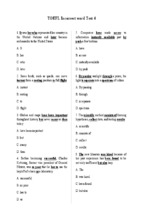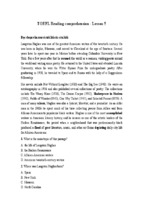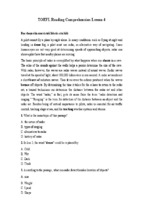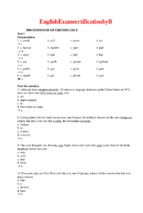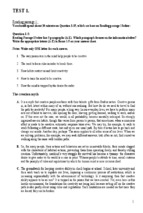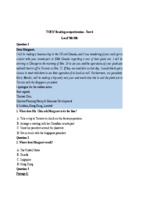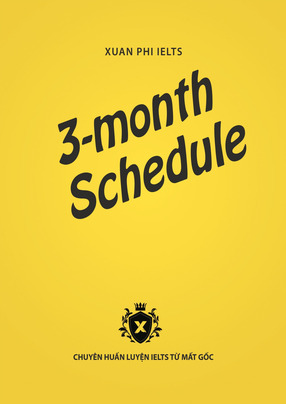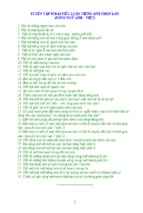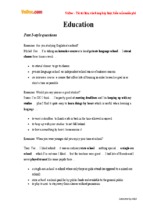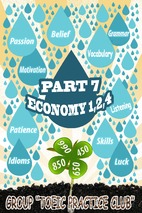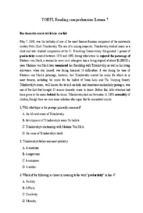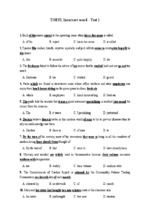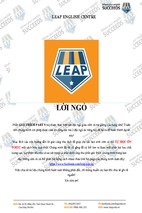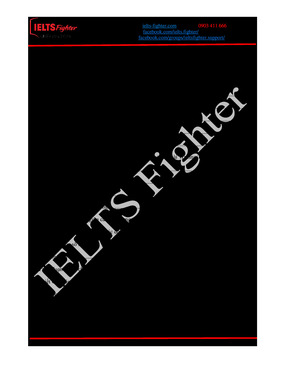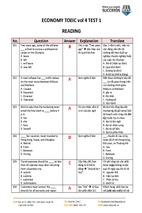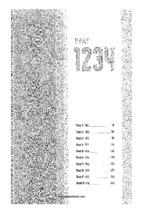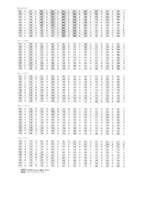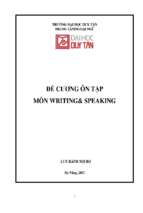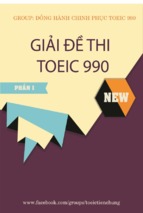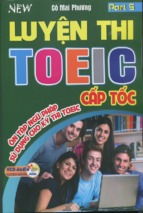Cambridge IELTS 3
Examination papers from the
University of Cambridge
Local Examination Syndicate
C AMBRIDGE
UNIVERSITY PRESS
PUBLISHED BY THE PRESS SYNDICATE OF THE UNIVERSITY OF CAMBRIDGE
The Pitt Building, Trumpington Street, Cambridge, United Kingdom
CAMBRIDGE UNIVERSITY PRESS
The Edinburgh Building, Cambridge CB2 2RU, UK
40 West 20th Street, New York NY 10011-4211, USA
477 Williamstown Road, Port Melbourne, VIC 3207, Australia
Ruiz de Alarcon 13, 28014 Madrid, Spain
Dock House, The Waterfront, Cape Town 8001, South Africa
http://www.cambridge.org
© Cambridge University Press 2002
This book is in copyright. Subject to statutory
exception and to the provisions of relevant
collective licensing agreements, no reproduction
of any part may take place without the written
permission of Cambridge University Press.
First published 2002
Reprinted 2003 (twice)
Printed in the United Kingdom at the University Press, Cambridge
Typeface Times NRMT 11/13pt System QuarkXPress™ [SE]
ISBN 0 521 01333 X Student's Book with answers
ISBN 0 521 01335 6 Cassette Set
ISBN 0 521 01336 4 Audio CD Set
ISBN 0 521 01337 5 Self-study Pack
Contents
Acknowledgements
Introduction
Test 1
8
Test 2
30
Test 3
54
Test 4
76
iv
1
General Training: Reading and Writing Test A
100
General Training: Reading and Writing Test B
114
Tapescripts
Answer key
127
149
Model and sample answers for writing tasks
Sample answer sheets
171
159
Acknowledgements
The authors and publishers are grateful to the authors, publishers and others who have given permission for the use of
copyright material identified in the text. It has not been possible to identify the sources of all the material used and in such
cases the publishers would welcome information from copyright owners. Apologies are expressed for any omissions.
Text p.24 from an extract 'Getting into the System' in How to Get a PhD 3rd edition by Estelle Phillips and
Derek Pugh, published in 1994 by © Open University Press 2000; Text p.38-39 from adapted text A Hard
earned Pat for a True Digger' by John Feehan, Volume 20, published in 1994 by © Australian Geographic;
Text 43-44 an extract from 'Natural Resource Management - the case of Farm Subsidies' by Frances
Cairncross, Published in 1995 by © Kogan Page; Text p.60 an extract from 'Collecting the 20th Century' from
the Department of Ethnography by Frances Carey, published in by The British Museum Press; Text p.84-85 an
extract 'Must Megacities mean Megapollutiori, from © The Economist Newspaper Limited, London September
1994; Text p.88-89 an extract from 'Nelson's Column, Votes for Women by Mary Alexander, published in 1992
by © The Illustrated London News; Text p.92-92 Reprinted by Permission of Harvard Business Review, from
'Management: A Book of Readings' by Harold Koontz, Volume 36, March-April 1958. Copyright © 1958 by
the Harvard Business School Publishing Corporation; all rights reserved; Text p. 100—101 Enrolment details,
conditions and fees, published in 1995 by The Francis King School of English; Text p. 106 an extract from 'the
University of Waikato Language Institute New Zealand', published in 1995 by © Waikato University; Text p.
122-123 © Alan Mitchell/Times Newspapers Limited, London 16 October 1995.
The publishers are grateful to the following for permission to include photographs:
Art Directors & TRIP/R Nichols for p. 47; Robert Harding Picture Library for p. 58; Tony Waltham for pp. 84, 108(r); Paul
Mulcahy for p. 19; Popperfoto for pp. 88, 106; Science Photo Library/Crown Copyright/Health and Safety Laboratory for p.
108(1); John Reader for p. 38; South American Pictures/Marion & Tony Morrison for p. 60.
Picture research by Valerie Mulcahy
Design concept by Peter Ducker MSTD
Cover design by John Dunne
The cassettes and audio CDs which accompany this book were recorded at Studio AVP, London.
Introduction
The International English Language Testing System (IELTS) is widely recognised as a reliable
means of assessing whether candidates are ready to study or train in the medium of English. IELTS
is owned by three partners, the University of Cambridge Local Examinations Syndicate, the British
Council and IDP Education Australia (through its subsidiary company IELTS Australia Pty
Limited). The main purpose of this book of Practice Tests is to give future IELTS candidates an idea
of whether their English is at the required level. Further information on IELTS can be found in the
IELTS Handbook available free of charge from IELTS centres.
WHAT IS THE TEST FORMAT?
IELTS consists of six modules. All candidates take the same Listening and Speaking modules. There
is a choice of Reading and Writing modules according to whether a candidate is taking the
Academic or General Training version of the test.
Academic
For candidates taking the test for entry to
undergraduate or postgraduate studies or for
professional reasons
Genera] Training
For candidates taking the test for entry to
vocational or training programmes not at
degree level, for admission to secondary
schools and for immigration purposes
The test modules are taken in the following order:
Listening
4 sections, 40 items
30 minutes
Academic Reading
3 sections, 40 items
60 minutes
Academic Writing
2 tasks
60 minutes
OR
OR
General Training Reading
3 sections, 40 items
60 minutes
General Training Writing
2 tasks
60 minutes
Speaking
11 to 14 minutes
Total test time
2 hours 44 minutes
1
Introduction
Listening
This is in four sections, each with 10 questions. The first two sections are concerned with social
needs. There is a conversation between two speakers and then a monologue. The final two sections
are concerned with situations related to educational or training contexts. There is a conversation
between up to four people and then a monologue.
A variety of question types is used, including: multiple choice, short-answer questions, sentence
completion, notes/chart/table completion, labelling a diagram, classification, matching.
Candidates hear the recording once only and answer the questions as they listen. Ten minutes are
allowed at the end to transfer answers to the answer sheet.
Academic Reading
There are three reading passages, of increasing difficulty, on topics of general interest and
candidates have to answer 40 questions. The passages are taken from magazines, journals, books
and newspapers. At least one text contains detailed logical argument.
A variety of question types is used, including: multiple choice, short-answer questions, sentence
completion, notes/chart/table completion, labelling a diagram, classification, matching lists/phrases,
choosing suitable paragraph headings from a list, identification of writer’s views/attitudes - yes, no,
not given, or true, false, not given.
General Training Reading
Candidates have to answer 40 questions. There are three sections of increasing difficulty, containing
texts taken from notices, advertisements, leaflets, newspapers, instruction manuals, books and
magazines. The first section contains texts relevant to basic linguistic survival in English, with tasks
mainly concerned with providing factual information. The second section focuses on the training
context and involves texts of more complex language. The third section involves reading more
extended texts, with a more complex structure, but with the emphasis on descriptive and instructive
rather than argumentative texts.
A variety of question types is used, including: multiple choice, short-answer questions, sentence
completion, notes/chart/table completion, labelling a diagram, classification, matching lists/phrases,
choosing suitable paragraph headings from a list, identification of writer’s views/attitudes - yes, no,
not given, or true, false, not given.
Academic Writing
There are two tasks and it is suggested that candidates spend about 20 minutes on Task 1, which
requires them to write at least 150 words, and 40 minutes on Task 2-250 words. The assessment of
Task 2 carries more weight in marking than Task 1.
In Task 1 candidates are asked to look at a diagram or table and to present the information in their
own words. They are assessed on their ability to organise, present and possibly compare data,
describe the stages of a process, describe an object or event, explain how something works.
2
Introduction
In Task 2 candidates are presented with a point of view, argument or problem. They are assessed
on their ability to present a solution to the problem, present and justify an opinion, compare and
contrast evidence and opinions, evaluate and challenge ideas, evidence or arguments.
Candidates are also judged on their ability to write in an appropriate style.
General Training Writing
There are two tasks and it is suggested that candidates spend about 20 minutes on Task 1, which
requires them to write at least 150 words, and 40 minutes on Task 2-250 words. The assessment of
Task 2 carries more weight in marking than Task 1.
In Task 1 candidates are asked to respond to a given problem with a letter requesting information
or explaining a situation. They are assessed on their ability to engage in personal correspondence,
elicit and provide general factual information, express needs, wants, likes and dislikes, express
opinions, complaints, etc.
In Task 2 candidates are presented with a point of view, argument or problem. They are assessed
on their ability to provide general factual information, outline a problem and present a solution,
present and justify an opinion, evaluate and challenge ideas, evidence or arguments.
Candidates are also judged on their ability to write in an appropriate style.
Speaking
The Speaking module takes between 11 and 14 minutes. It consists of an oral interview between the
candidate and an examiner.
There are three main parts:
Part 1
The candidate and the examiner introduce themselves and then the candidate answers general
questions about themselves, their home/family, their job/studies, their interests and a wide range of
similar familiar topic areas. This part lasts between four and five minutes.
Part 2
The candidate is given a task card with prompts and is asked to talk on a particular topic.
The candidate has one minute to prepare and they can make some notes if they wish, before
speaking for between one and two minutes. The examiner then asks one or two rounding-off
questions.
Part 3
The examiner and the candidate engage in a discussion of more abstract issues and concepts, which
are thematically linked to the topic prompt in Part 2. The discussion lasts between four and five
minutes.
The Speaking module assesses whether candidates can communicate effectively in English. The
assessment takes into account Fluency and Coherence, Lexical Resource, Grammatical Range and
Accuracy, and Pronunciation.
3
Introduction
HOW IS IELTS SCORED?
IELTS results are reported on a nine-band scale. In addition to the score for overall language ability
IELTS provides a score, in the form of a profile, for each of the four skills (Listening, Reading,
Writing and Speaking). These scores are also reported on a nine-band scale. All scores are recorded
on the Test Report Form along with details of the candidate’s nationality, first language and date of
birth. Each Overall Band Score corresponds to a descriptive statement which gives a summary of the
English language ability of a candidate classified at that level. The nine bands and their descriptive
statements are as follows:
9 Expert User — Has fully operational command of the language: appropriate, accurate and fluent with complete
understanding.
8 Very Good User - Has fully operational command of the language with only occasional unsystematic
inaccuracies and inappropriacies. Misunderstandings may occur in unfamiliar situations. Handles complex
detailed argumentation well.
7 Good User - Has operational command of the language, though occasional inaccuracies, inappropriacies and
misunderstandings in some situations. Generally handles complex language well and understands detailed
reasoning.
6 Competent User - Has generally effective command of the language despite some inaccuracies, inappropriacies
and misunderstandings. Can use and understand fairly complex language, particularly in familiar situations.
5 Modest User — Has partial command of the language, coping with overall meaning in most situations, though is
likely to make many mistakes. Should be able to handle basic communication in own field.
4 Limited User — Basic competence is limited to familiar situations. Has frequent problems in understanding and
expression. Is not able to use complex language.
3 Extremely Limited User - Conveys and understands only general meaning in very familiar situations. Frequent
breakdowns in communication occur.
2 Intermittent User - No real communication is possible except for the most basic information using isolated
words or short formulae in familiar situations and to meet immediate needs. Has great difficulty understanding
spoken and written English.
1 Non User - Essentially has no ability to use the language beyond possibly a few isolated words.
0 Did not attempt the test. — No assessable information.
Most universities and colleges in the United Kingdom, Australia, New Zealand and Canada accept
an IELTS Overall Band Score of 6.0 or 6.5 for entry to academic programmes. IELTS scores are
increasingly being recognised by universities in the USA.
4
Introduction
MARKING THE PRACTICE TESTS
Listening and Reading
The Answer key is on pages 149-158.
Each item in the Listening and Reading tests is worth one mark. There are no half marks. Put a
tick (a ) next to each correct answer and a cross (r ) next to each wrong one. Each tick will equal
one mark.
Single letter/number answers
• For questions where the answer is a single letter or number, you should write only one answer. If
you have written more than one, the answer must be marked wrong.
Longer answers
• Only the answers given in the Answer key are correct. If you write something different to the
answer given in the key, it should be marked wrong.
• Answers may be written in upper or lower case.
• Sometimes part of the correct answer is given in brackets. Words in brackets are optional - they
are correct, but not necessary.
• Alternative words or phrases within an answer are indicated by a single slash (/).
• Sometimes there are alternative correct answers to a question. In these cases the possible answers
are separated by a double slash (//). If you have written any one of these possible answers, your
answer is correct.
• You will find additional notes about individual questions in the Answer key.
Spelling
• All answers require correct spelling unless alternative spellings are stated in the Answer key. If a
word is spelt differently from the Answer key, it should be marked wrong.
• Both US and UK spelling are acceptable.
Writing
Obviously it is not possible for you to give yourself a mark for the Writing tasks. For Tests 2 and 3
and GT Test A we have provided model answers (written by an examiner) at the back of the book. It
is important to note that these show just one way of completing the task, out of many possible
approaches. For Tests 1 and 4 and GT Test B we have provided sample answers (written by
candidates), showing their score and the examiner’s comments. We hope that both of these will give
you an insight into what is required for the Writing module.
5
Introduction
HOW SHOULD YOU INTERPRET YOUR SCORES?
In the Answer key at the end of each set of Listening and Reading answers you will find a chart
which will help you assess if, on the basis of your practice test results, you are ready to take the
IELTS exam.
In interpreting your score, there are a number of points you should bear in mind.
Your performance in the real IELTS test will be reported in two ways: there will be a Band Score
from 1 to 9 for each of the modules and an Overall Band Score from 1 to 9, which is the average of
your scores in the four modules.
However, institutions considering your application are advised to look at both the Overall Band
and the Bands for each module. They do this in order to see if you have the language skills needed
for a particular course of study. For example, if your course has a lot of reading and writing, but no
lectures, listening comprehension might be less important and a score of 5 in Listening might be
acceptable if the Overall Band Score was 7. However, for a course where there are lots of lectures
and spoken instructions, a score of 5 in Listening might be unacceptable even though the Overall
Band Score was 7.
Once you have marked your papers you should have some idea of whether your Listening and
Reading skills are good enough for you to try the real IELTS test. If you did well enough in one
module but not in others, you will have to decide for yourself whether you are ready to take the
proper test yet.
The Practice Tests have been checked so that they are about the same level of difficulty as the real
IELTS test. However, we cannot guarantee that your score in the Practice Test papers will be
reflected in the real IELTS test. The Practice Tests can only give you an idea of your possible future
performance and it is ultimately up to you to make decisions based on your score.
Different institutions accept different IELTS scores for different types of courses. We have based
our recommendations on the average scores which the majority of institutions accept. The institution
to which you are applying may, of course, require a higher or lower score than most other
institutions.
Sample answers or model answers are provided for the Writing tasks. The sample answers were
written by IELTS candidates; each answer has been given a band score and the candidate’s
performance is described. Please note that the examiner’s guidelines for marking the Writing scripts
are very detailed. There are many different ways a candidate may achieve a particular band score.
The model answers were written by an examiner as examples of very good answers, but it is
important to understand that they are just one example out of many possible approaches.
6
Introduction
Further information
For more information about IELTS or any other UCLES examination write to:
EFL Division
UCLES
1 Hills Road
Cambridge
CB1 2EU
England
Telephone: +44 1223 553311
Fax: +44 1223 460278
e-mail:
[email protected]
http://www.cambridge-efl.org.uk
7
Test 1
LISTENING
SECTION 1
Questions 1-10
Complete the notes below.
8
Listening
SECTON 2
Questions 11-20
Questions 11 and 12
Write NO MORE THAN THREE WORDS for each answer.
11
Who is Mrs Sutton worried about?
……………………………………………..
12
What is the name for a group of family doctors working in the same building together?
………………………………………..
Questions 13-17
Complete the table below.
Write NO MORE THAN THREE WORDS OR A NUMBER for each answer.
Name of Health
Centre
Number of doctors
Other information
Information about
doctors
Dean End
13.............................
Appointment system
15.............................
than South Hay
Dr Jones is good with
16.............................
patients.
Dr Shaw is good with
small children.
South Hay
14.............................
Building less modern than Dr Williams helps people
Dean End
with 17.............................
………………….
9
Test 1
Questions 18-20
Question 18
Write NO MORE THAN TWO WORDS OR A NUMBER.
Doctors start seeing patients at the Health Centre from........................o’clock.
Question 19
Choose TWO letters A-E.
Which TWO groups of patients receive free medication?
A people over 17 years old
B unemployed people
C non-UK residents
D people over 60 years old
E pregnant women
Question 20
Write NO MORE THAN TWO WORDS OR A NUMBER
The charge for one item of medication is about £..................................
10
Listening
SECTION 3
Questions 21-30
Complete the notes below.
Write NUMBERS AND/OR NO MORE THAN THREE WORDS for each answer.
11
Test 1
SECTION 4
Questions 31-40
Questions 31-36
Choose the correct letters A-C.
31
Which column of the bar chart represents the figures quoted?
32
According to the speaker, the main cause of back pain in women is
A pregnancy.
B osteoporosis.
C lack of exercise.
33 As treatment for back pain the Clinic mainly recommends
A pain killers.
B relaxation therapy.
C exercise routines.
34
The back is different from other parts of the body because
A
B
C
35
Bed rest is advised
A
B
C
36
for a maximum of two days.
for extreme pain only.
for pain lasting more than two days.
Being overweight
A
B
C
12
it is usually better at self-repair.
a back injury is usually more painful.
its response to injury often results in more damage.
is a major source of back pain.
worsens existing back pain.
reduces the effectiveness of exercise.
Listening
Questions 37-40
Choose the correct letters A—C.
Strongly
recommended
A
Recommended
in certain
circumstances
B
Not
recommended
C
Example
Diet if overweight
Answer
[A]
B
C
37 Buy special orthopaedic
chairs
A
B
C
Example
Buy orthopaedic
mattresses
A
Answer
[B]
C
38 Buy shock-absorbing
inserts
A
B
C
39 Wear flat shoes
A
B
C
40 Buy TENS machine
A
B
C
13
Test 1
READING_
READING PASSAGE 1
You should spend about 20 minutes on Questions 1-14 which are based on Reading Passage 1 on
the following pages.
Questions 1-4
Reading Passage 1 has six paragraphs A-F.
Choose the most suitable headings for paragraphs B-E from the list of headings below.
Write the appropriate numbers i-ix in boxes 1—4 on your answer sheet.
List of Headings
How the reaction principle works
ii
The impact of the reaction principle
iii
Writers’ theories of the reaction principle
iv
Undeveloped for centuries
v
The first rockets
vi
The first use of steam
vii Rockets for military use
viii Developments of fire
ix
What’s next?
i
Example
Paragraph A
1
Paragraph B
2
Paragraph C
3
Paragraph D
4
Paragraph E
Example
Paragraph F
14
Answer
ii
Answer
ix
Reading
THE ROCKET - FROM EAST TO WEST
A The concept of the rocket, or rather the mechanism behind the idea of propelling an
object into the air, has been around for well over two thousand years. However, it
wasn’t until the discovery of the reaction principle, which was the key to space travel
and so represents one of the great milestones in the history of scientific thought, that
rocket technology was able to develop. Not only did it solve a problem that had
intrigued man for ages, but, more importantly, it literally opened the door to
exploration of the universe.
B
An intellectual breakthrough, brilliant though it may be, does not automatically
ensure that the transition is made from theory to practice. Despite the fact that
rockets had been used sporadically for several hundred years, they remained a
relatively minor artefact of civilisation until the twentieth century. Prodigious efforts,
accelerated during two world wars, were required before the technology of primitive
rocketry could be translated into the reality of sophisticated astronauts. It is strange
that the rocket was generally ignored by writers of fiction to transport their heroes to
mysterious realms beyond the Earth, even though it had been commonly used in
fireworks displays in China since the thirteenth century. The reason is that nobody
associated the reaction principle with the idea of travelling through space to a
neighbouring world.
C A simple analogy can help us to understand how a rocket operates. It is much like a
machine gun mounted on the rear of a boat. In reaction to the backward discharge of
bullets, the gun, and hence the boat, move forwards. A rocket motor’s ‘bullets’ are
minute, high-speed particles produced by burning propellants in a suitable chamber.
The reaction to the ejection of these small particles causes the rocket to move
forwards. There is evidence that the reaction principle was applied practically well
before the rocket was invented. In his Noctes Atticae or Greek Nights, Aulus Gellius
describes ‘the pigeon of Archytas’, an invention dating back to about 360 BC.
Cylindrical in shape, made of wood, and hanging from string, it was moved to and fro
by steam blowing out from small exhaust ports at either end. The reaction to the
discharging steam provided the bird with motive power.
D
The invention of rockets is linked inextricably with the invention of ‘black powder’.
Most historians of technology credit the Chinese with its discovery. They base their
belief on studies of Chinese writings or on the notebooks of early Europeans who
settled in or made long visits to China to study its history and civilisation. It is
probable that, some time in the tenth century, black powder was first compounded
from its basic ingredients of saltpetre, charcoal and sulphur. But this does not mean
that it was immediately used to propel rockets. By the thirteenth century, powderpropelled fire arrows had become rather common. The Chinese relied on this type of
technological development to produce incendiary projectiles of many sorts,
15

